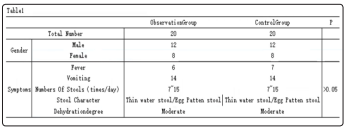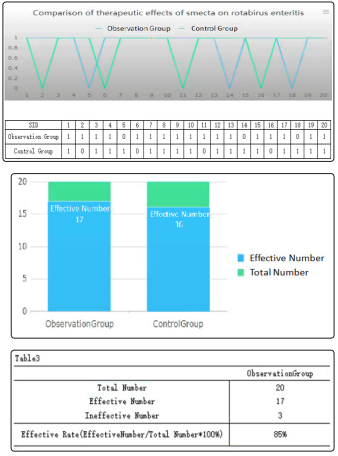Author(s): Cheng Xiao
Objective: To explore the clinical effect of Smecta in treating rotavirus enteritis. Methods: 40 children with rotavirus enteritis treated in our hospital were randomly divided into observation group and control group. The observation group was treated with smecta plus routine treatment, while the control group was treated with routine treatment. The efficacy and adverse reactions of the two groups were compared.
Results: The effect of smecta in observation group was not clear.
Rotavirus enteritis is the second common disease and frequentlyoccurring disease after respiratory tract infection, which is more common in infants aged 6 months to 2 years old. It is also called autumn diarrhea because of its frequent occurrence in autumn. It is mainly caused by rotavirus infection, and its clinical manifestations are diarrhea, vomiting, fever, dehydration, etc. If it is not treated in time, it can cause serious dehydration and electrolyte disorder. At present, there is no specific treatment. Although various antiviral treatments have certain effects, they are still not ideal. Clinical observation of Smecta in our hospital outpatient treatment of 40 patients with rotavirus enteritis, the therapeutic effect is reported as follows:
From September 2018 to May 2019,40 children with rotavirus enteritis were treated in our hospital, including 24 males and 16 females; The age ranged from 6 to 30 months. The course of disease was 3 ~5 days. The stool is dilute water sample or egg flower soup sample, and the stool frequency is 7~15 times/d; Fever 13 cases, vomiting 28 cases; All patients were moderately dehydrated. The stool rotavirus antigen of all children was positive, which met the diagnostic criteria of rotavirus enteritis in Pediatrics. The children were randomly divided into two groups, the observation group and the control group, with 20 cases in each group. There was no significant difference in general data such as age, sex and course of disease between the two groups (P>0.05).

Both groups were given routine fluid replacement, anti-infection and maintenance of water, electrolyte and acid-base balance, and those with complications were given symptomatic treatment. The treatment group was given smecta [1].
The curative effect was judged according to the standards formulated by the National Symposium on Diarrhea Prevention and Control [2]. Significant effect: after 72 hours of treatment, the clinical symptoms disappeared completely, the stool frequency and characteristics returned to normal, and the fecal RV-Ag turned negative; Effective: 72
After h, the clinical symptoms disappeared basically, the stool frequency and its characters improved obviously, and the fecal RV-Ag turned negative. Invalid: pro.
Bed symptoms, stool frequency and characteristics did not improve or even worsen, and RV-Ag in stool was still positive. Total effective rate = (obviously effective cases+effective cases)/ total cases X100%.
Input the data into the computer to establish EXCEL database, and use SPSS 13.0 software to do data processing Physical and statistical analysis, rank sum test for grade data comparison, x2 test for qualitative data comparison, P
Comparison of Curative Effects

The total effective rate was 85% (17/20) in the observation group and 80%(16/20) in the control group. The difference between the two groups was statistically significant (P<0.05).
After the course of treatment in the observation group, the blood routine examination showed that there were no obvious changes in white blood cells and platelets, 1 case had nausea and vomiting, and no other adverse reactions were found. The incidence of adverse reactions was 5%; In the control group, 2 cases had rash, and no other obvious adverse reactions such as changes in liver and kidney function were found. The incidence of adverse reactions was 10%; The difference between the two groups was statistically significant.
Rotavirus is the most common pathogen of infantile autumn diarrhea, and its pathogenesis is that rotavirus invades small intestinal mucosa, which destroys villous cells of intestinal wall, reduces disaccharide enzyme activity, and impairs the ability of small intestinal mucosa to absorb water and electrolyte. Meanwhile, due to the obstruction of solute transport, a large number of watery stools or repeated vomiting, water and electrolyte are lost from digestive tract, resulting in water and electrolyte disorder and a series of poisoning symptoms. Therefore, it is of great significance to restore and maintain the function of intestinal mucosal epithelial cells for the treatment of rotavirus enteritis [3].
Smecta is a new type of digestive tract mucosal protective agent composed of double tetrahedral silica and octahedral alumina. Pharmacodynamics shows that Smecta can adsorb a variety of pathogens, fix them on the surface of intestinal cavity, and then excrete them with intestinal peristalsis, thus avoiding intestinal cells from being damaged by pathogens; Smecta can also fix a variety of bacterial toxins, restore the normal rhythm of intestinal peristalsis, and maintain the intestinal transport and absorption function w [4-5]. In addition, smecta can alleviate and repair the damage of Campylobacter jejuni to intestinal mucosa and inhibit its reproduction; On the other hand, smecta can slow down the transformation speed of intestinal cells, promote the absorption function of intestinal cells, reduce their secretion, alleviate the osmotic diarrhea caused by indigestion of sugar and fat due to the decrease or lack of disaccharidase in children, and increase the cohesion, mucous membrane elasticity and existence time of mucus gel through the interaction with intestinal mucus molecules, thereby strengthening the mucus barrier and protecting the top of intestinal cells and intercellular bridges from damage [6]. and smecta does not enter the blood circulation system.
In this study, the total effective rate of smecta in the observation group was 93.3%, which was much higher than that in the control group, because smecta could cover the whole intestinal cavity surface evenly, protect intestinal mucosa, reduce its secretion, promote absorption, improve the balance of intestinal parasitic bacteria, and play an anti-infection and antidiarrheal role. At the same time, it does not interfere with the normal absorption function of intestinal tract, and can promote the absorption function of normal cells, reduce the dyskinesia of intestinal cells, and obviously reduce the loss of water and electrolyte, thus providing a guarantee for eating.
In a word, Smecta has obvious curative effect on intestinal inflammatory diseases including rotavirus enteritis in theory, but this clinical experiment shows that Smecta has certain effect on rotavirus enteritis, but the curative effect has not reached the expected and theoretical obvious effect; And WHO did not regard smecta as an essential drug for the treatment of rotavirus enteritis. In addition, according to the observation of this clinical experiment, Smecta can obviously delay the peak period of rotavirus enteritis and diarrhea, which leads to a thinking, whether Smecta can prolong the course of rotavirus enteritis. It is suggested to carry out larger clinical trials to determine the efficacy of smecta.
